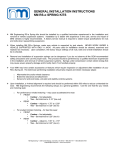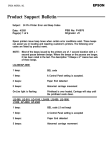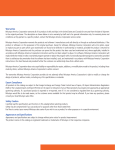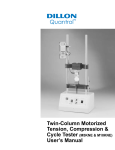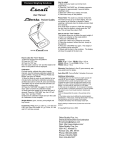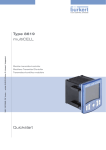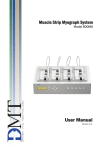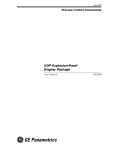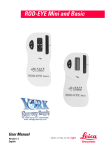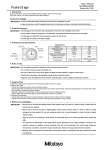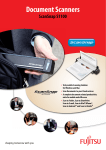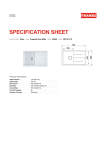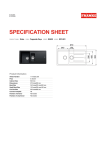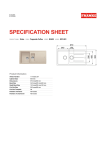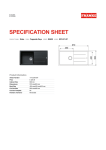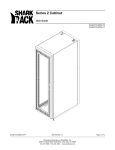Download Basic Force Gauge User`s Manual
Transcript
Basic Force Gauge User’s Manual EUROPEAN COUNTRIES WARNING This is a Class A product. In a domestic environment this product may cause radio interference in which the user may be required to take adequate measures. CAUTION Risk of electrical shock. Do not remove cover. No user serviceable parts inside. Refer servicing to qualified service personnel. Weigh-Tronix reserves the right to change specifications at any time. 02/04/03 BFG_U.P65 PN 29798-0013A e1 Printed in USA 2 Basic Force Gauge User’s Manual Table of Contents Table of Contents ........................................................................................... 3 Specifications ................................................................................................. 4 Capacity and Divisions ........................................................................... 4 Accuracy ................................................................................................. 4 Output ..................................................................................................... 4 Introduction .................................................................................................... 5 BFG Power Supply ................................................................................. 5 Operation ....................................................................................................... 6 Fitting Accessories ................................................................................. 6 Mounting to a test stand ......................................................................... 6 Powering up ............................................................................................ 6 Display of Tension/Compression ............................................................ 7 Zeroing the Gauge ................................................................................. 8 Changing the unit of measurement ........................................................ 8 Max (Peak) Readings ............................................................................. 8 “Max” mode ..................................................................................... 8 Dual Max ......................................................................................... 9 Max Tension .................................................................................... 9 Max Compression ........................................................................... 9 “Normal” mode ................................................................................ 9 Data Output ................................................................................... 10 Optional Settings .................................................................................. 10 Backlit Display ............................................................................... 10 Auto-off .......................................................................................... 10 Invert Display Text ......................................................................... 11 Load cell Diagnostic test ............................................................... 11 Appendix A ................................................................................................... 13 Basic Force Gauge User’s Manual 3 Specifications Capacity and Divisions Model No: mN N kN g-f kg-f oz-f* BFG 10 10000 x 2 10 x 0.002 - BFG 50 50000 x 10 50 x 0.01 - 5000 x 1 BFG 200 - 200 x 0.05 - 20000 x 5 20 x 0.005 720 x 0.2 44 x 0.01 BFG 500 - 500 x 0.1 - 50000 x 10 50 x 0.01 1800 x 0.5 110 x 0.02 BFG 1000 - 1000 x 0.2 1 x 0.0002 - 100 x 0.02 3500 x 1 220 x 0.05 BFG 2500 - 2500 x 0.5 2.5 x 0.0005 - 250 x 0.05 - 550 x 0.1 1000 x 0.2 1 x 0.0002 35 x 0.01 5 x 0.001 180 x 0.05 lb-f* 2.2 x 0.0005 11 x 0.002 * Due to internal rounding, occassional jumps of twice the increment size may occur. Accuracy ±0.25% of full-scale, ±least significant digit Calibration temperature: 20°C ±2°C Operating temperature: 10°C - 35°C Temperature shift at zero load: scale/°C Output RS-232: ±0.09% of full- 8 data bits, 1 Start bit, 1 Stop bit, no parity Digimatic (Mitutoyo) format Analog: 2.5V at zero load, ±1.5V approximately for full-scale tension/compression Voltage obtained from analog conditioning of the load cell. Actual voltages will vary by capacity and also by individual instruments. Actual voltage can be captured by applying reference load and measuring or capturing voltage. 4 Basic Force Gauge User’s Manual Introduction The QuantrolTM Basic Force Gauge (BFG) can measure tensile and compressive forces accurately while still being easy to operate. Please check the unit for any physical damage. If any damage is found, please notify your authorized Quantrol dealer. The most commonly used features of the BFG are accessed with a single key press on the instrument: • • • • displaying force peak hold zero changing units of measure Other features can be accessed easily by pressing and holding different 2 key combinations. BFG Power Supply The BFG comes with five Nickel Metal Hydride AAA rechargeable batteries. For safety reasons the batteries are shipped discharged. To obtain maximum battery life we recommend that you charge them with the charger/adaptor supplied for at least 14 - 16 hours when you first receive the BFG. To insert the batteries you must first remove the battery cover on the rear of the gauge by unscrewing the two retaining screws. Fit the batteries in the battery holder. Be sure to match the marked polarity. Refit the battery cover and tighten the screws. When alkaline batteries are fitted, the AC adaptor/charger must NEVER be connected to the BFG due to risk of acid leakage which could damage the instrument. Connect the AC adaptor/charger to the BFG charger socket and charge the batteries for 14 - 16 hours. Only use the adaptor/charger supplied. The BFG can also be powered directly from the AC adaptor. You can do this with or without the rechargeable batteries installed. Connect the AC adaptor/ charger to the BFG and a properly grounded outlet of the correct voltage. Only use the adaptor/charger supplied. If the rechargeable batteries are installed, a trickle charge will continue during AC use of the unit. The BFG can also be powered by AAA 1.5V alkaline batteries (not supplied). Follow the same instructions as above, except for use of the charger. See warning at left. Basic Force Gauge User’s Manual 5 Operation Fitting Accessories Affix either the short extension rod (30mm long) or the long extension rod (130mm long) to the load cell probe in the hole at the bottom of the gauge by tightening it gently with the fingers. Your chosen grip or accessory may now be connected to the extension rod. When fitting a grip ensure that it is screwed fingertight only. Excessive torque can damage the load cell. Mounting to a test stand On the rear of the gauge there are two M5 threaded holes, which can be used for mounting the gauge to a Quantrol test stand. Each Quantrol test stand is supplied with a dedicated ‘dovetailed mounting bracket’ and screws for this purpose. If you wish to mount the gauge to another type of stand, ensure that the screws used are threaded into the gauge to a maximum depth of .21 inch (5.5mm). The final thread is peaned but if screws are fitted beyond this depth, damage to the load cell will occur. Powering up As shown in Figure 1 the control panel has 6 keys. Figure 1 BFG keys 6 Basic Force Gauge User’s Manual A BFG measuring very low forces may not show zero if it is moved during the self test routine. Once it is properly mounted and zeroed the reading will be stable. To power up the gauge press the ON/OFF key. A short self test runs during which the display will show the model and capacity in Newtons. After the self test, providing no load has been applied to the instrument, the display will show all zeroes. This is because the gauge re-zeroes itself during the self test routine. See note at left. If a force is applied perpendicularly via the sensor probe (hole at bottom of BFG), the reading on the display will register the applied force. Forces greater than 120% of full-scale will produce an audible beep until load is released and an OL symbol will appear on the display for 30 seconds. Do not overload the transducer, as this will cause irreparable damage. Display of Tension/ Compression If the BFG has suffered a serious overload condition, the load indicator bar will be partially displayed even when no load is present. This is a warning that the load cell is damaged and you should immediately contact your Quantrol distributor to arrange repair. The load indicator bar is independent of the zero function and thus provides good visual reference of potential overload conditions. Forces greater than 150% of full-scale will produce an audible beep until load is released and an OL symbol will appear permanently on the display. Consult your Quantrol distributor to arrange repair. To power down the BFG press the ON/OFF key. When tensile forces are applied, the tension symbol shown in Figure 2 is displayed. Figure 2 Tension symbol When compression forces are applied, the compression symbol shown below is displayed. A load indicator bar alerts the operator to how much load has been applied to the transducer. As the load approaches the maximum rating of the transducer, the indicator bar changes appearance when above approximately 80% of the rated capacity. This warns you that steps should be taken to prevent overloading Basic Force Gauge User’s Manual 7 the transducer. For tensile forces the indicator bar is solid then dotted. For compressive forces the indicator bar is dotted then solid. See Figures 3b & 3c Zeroing the Gauge During the operation of the gauge it is often necessary to zero the display – e.g. when you wish to tare out the weight of a grip, so it does not become part of the measured reading. Press and release the ZERO key. The display will blink momentarily as the zero operation is carried out. Any load applied prior to zeroing must be considered as part of the full-scale capacity. Changing the unit of measurement You can choose from the following units of measurement depending on the capacity of your gauge: milliNewtons, Newtons, gram-force, kilogram-force, ounce-force or pound-force. To change the display units press and release the UNITS key. Each successive key press will select the next available unit of measure until the gauge returns to its original setting. The BFG automatically converts readings as new units of measure are selected. Max (Peak) Readings “Max” mode 8 The gauge detects and stores maximum (peak) force in both compressive and tensile directions. Press the MAX key. The display will show the word MAX together with the highest tensile force and the highest compressive force detected during the test. The current load being applied to the transducer is also displayed. Basic Force Gauge User’s Manual Dual Max Figure 3a MAX dual readings Max Tension Press the MAX key again and the display will show the maximum tensile force identified by the symbol. Figure 3b MAX tension Max Compression Press the MAX key again and the display will show the maximum compressive force identified by the symbol. Figure 3c MAX compression “Normal” mode Press the MAX key again and the word MAX disappears from the display. The display indicates forces applied in both directions as they are applied to the transducer and maintains a running display. Basic Force Gauge User’s Manual 9 Press the RESET key to clear both maximum registers and prepare for detecting the next maximum readings. Data Output BFG uses 9600 Baud 8 data bits, 1 start bit 1 stop bit and no parity. A full range of data cables are available to connect your gauge to peripheral devices – contact your supplier. The BFG has RS-232, Mitutoyo and analog output signals. It is possible to transmit the displayed reading to peripheral devices (e.g. PC, printer) by pressing and releasing the TXD key. Displayed readings can also be requested individually from a PC via the RS-232 interface by sending a”?” (ascii D63 [3fh] character. For sending a continuous data stream to a PC, press and hold the TXD key for 2 seconds then release. TX will now appear in the display to indicate that data is being sent. To stop sending data, simply press and release the TXD key, at which point TX will disappear from the display. Please note that the continuous data stream only starts when approximately 2% of the rated capacity of the gauge is reached. Optional Settings Backlit Display It is possible to activate a backlight on the BFG display. Press and hold RESET while powering up the BFG with the ON/OFF key. The backlight is now operating. The backlight will go out when the unit is powered off. Repeat the process to turn the backlight back on. Please note that battery consumption is doubled when using the backlight. Auto-off To conserve battery power, you can activate an Auto-off function so that the gauge powers down two minutes after the last key press. Press and hold ZERO while powering up the BFG with the ON/OFF key. The symbol Ao will appear in the display to indicate Auto-off is active. 10 Basic Force Gauge User’s Manual Invert Display Text For tension applications it is often desirable to invert the text on the display so that the operator can read it more comfortably. To invert the text, press and hold MAX while powering up the BFG with the ON/OFF key. The display is inverted. Load cell Diagnostic test If you suspect that your load cell transducer has sustained an overload it is possible to check the status of the load cell immediately. Symptoms of overload may be: An instrument showing an overload condition cannot be relied upon to provide accurate, repeatable measurement. Consult your Quantrol supplier. (a) OL in display (b) buzzer sound (c) probe not aligned perpendicular to gauge (d) load indicator bar present even under zero load Place the gauge horizontally on a flat level surface. Press and hold UNITS until the password menu appears with 0000 in the display. Press ZERO four times and you will now see two values shown as %. The upper value shows the % offset when the gauge was last successfully calibrated. The lower value shows the % offset currently present on the gauge. A significant offset, or change in offset, may indicate that the loadcell has been overloaded and sustained damage. Figure 4 Diagnostic screen If the % offset is between 5% - 10% please contact your supplier to arrange a recalibration of your BFG. If the % offset is greater than 10% please contact your supplier to arrange for a loadcell replacement. These values are given as an indicator only – the need for calibration/repair may vary according to the individual characteristics of the load cell. Basic Force Gauge User’s Manual 11 12 L o w er Valu e Actio n -4.9% to 4.9% Normal offset provi ded upper and lower values are wi thi n 5% of each other -5.0% to -9.9% 5% to 9.97% Contact Quantrol di stri butor for recali brati on -10% and greater 10% and greater Contact Quantrol di stri butor for loadcell replacement Basic Force Gauge User’s Manual Appendix A Pin Out 15 pin ‘D’ Connector Basic Force Gauge User’s Manual 1 Analog Output 2 RS-232 Transmit 3 RS-232 Receive 4 Mitutoyo Clock Output 5 Mitutoyo Ready Output 6 not used 7 not used 8 not used 9 not available 10 Ground 11 Mitutoyo Request Input 12 Mitutoyo Data Output 13 not used 14 not used 15 not used 13 14 Basic Force Gauge User’s Manual Basic Force Gauge User’s Manual 15 Distributor / Sales / Service & Calibration Dillon/Quality Plus, Inc. 3201 Corte Malpaso Unit 311 Camarillo, CA. 93012 Telephone: 800-225-6543 Facsimile: 805-388-2735 e-mail: [email protected] www.dqplus.com Precision Force Measurement Testing Systems


















